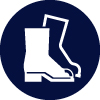
Fluorescent Tubes Hazardous 20 02 21
Fluorescent tubes are made of glass with metal caps at either end and filled with a gas containing mercury vapour and argon, xenon, neon, or krypton. Fluorescent tubes are made in various sizes and colours depending on the desired performance and architectural finish.
Usage & Probable Locations
Fluorescent tubes are used to generate light through a transparent or translucent aperture. They are used for ceiling lights, emergency signs, decorative electric lights, lighting behind panels and flood lights. They can be found in domestic, commercial and industrial buildings fixed to ceilings, walls, along corridors, in the roof, for architectural features and external lighting.
Personal Protective Equipment
PPE requirements indicated are for guidance purposes only. DRIDS has identified the PPE that is mandatory on all demolition projects and ones that may be required subject to site specific Risk Assessment & Method Statement (RAMS). Hover over the icon to determine the types of PPE required for the removal of this material.
Removal, Segregation & Storage
Fluorescent tubes or items of architectural and historic importance that contain fluorescent tubes that are destined for reuse should be deconstructed, segregated and stored carefully and safely. They should be stored upright in a purpose made fluorescent tube holder to prevent damage or breakage. Fluorescent tubes or crushed fluorescent tubes that are destined for recycling should be segregated and stored in purpose made holders (coffins) or a segregated skip, inside a building or under cover before removal from site accompanied with the appropriate paperwork.
Fixtures, Fittings & Connections
Fluorescent tubes are generally fixed in place at either end using pin and socket connections. Some fluorescent tubes will have additional clips to the tube to provide security within a frame. Most fluorescent tubes are contained within a light fitting or box that transmits light through a transparent or translucent screen. They will always be connected to an electrical circuit to generate light. All fixtures, fittings and boxes containing fluorescent tubes will be fixed in place using a wide range of fixings such as bolts, screws and expansion bolts.
Health & Safety
Subject to task-specific Risk Assessment & Method Statement (RAMS). Use correct protective equipment when working with fluorescent tubes. Turn off electricity circuit before removing tubes. Wear kevlar grip gloves when handling tubes and crushed tubes to prevent drops, cuts or abrasion. Use eye protection when removing tubes to prevent injury from dust or other particles. Avoid breaking tubes. Do not walk on crushed tubes. Use appropriate access equipment determined by RAMS. Store in fluorescent tube coffins.










